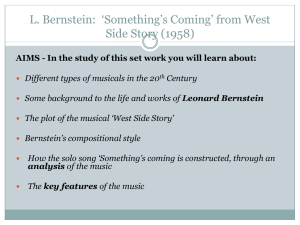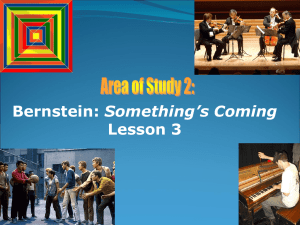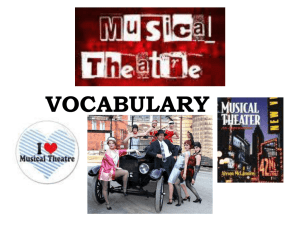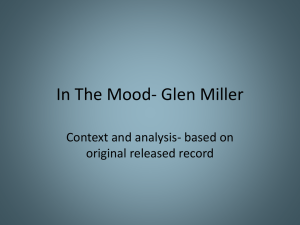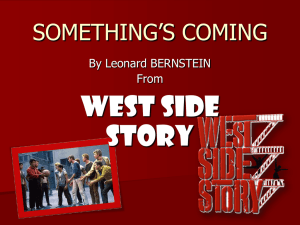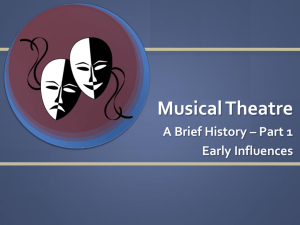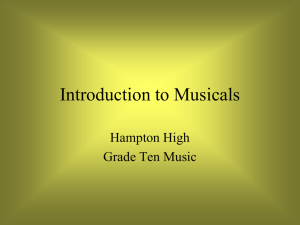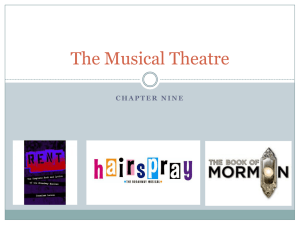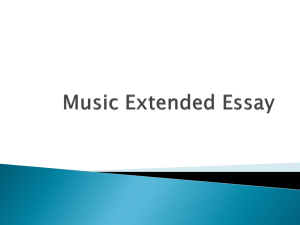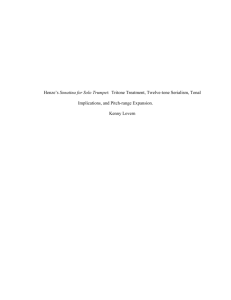Something*s Coming* from West Side Story Leonard Bernstein (1958)
advertisement
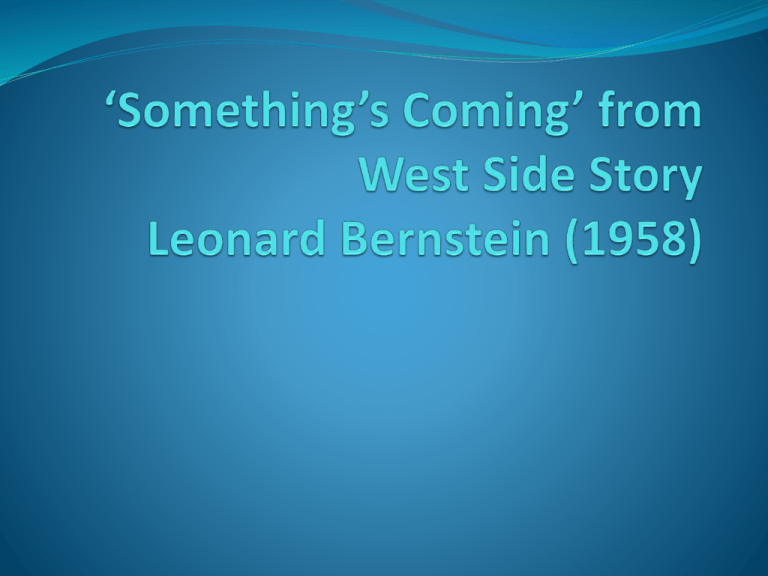
Origins Has had a long and colourful history Traced back to Ancient Greece to act out stories and morality plays for entertainment. Over the last 300yrs, the musical has evolved into many different styles of entertainment. Two of the oldest styles are Vaudeville and Burlesque. Vaudeville Popular in the 1700’s Popular songs borrowed from other works but with new, often vulgar, words set to music To shock and entertain the audience. Famous example = The Beggars Opera by John Gay, about thieves and prostitutes. Mozart used to attend Vaudeville with his wife and son and would often hear his work being made fun of on stage For the common people, not royalty and aristocracy. Burlesque Similar to Vaudeville, but more restrained and Classical in style. Subject matter usually a parody on other plays. Both Vaudeville and Burlesque were important in the development of opera-bouffe and operetta. Opera-Bouffe Means Comic Opera Popular from approx 1870 – End of WWI Still performed today Specially composed, rather than using other works Musical style = Light opera and includes some spoken dialogue Example = Orpheus in the Underworld by Offenbach (a comic version the Greek legend Orpheus and Eurydice) Very famous composers = Gilbert and Sullivan, who composed HMS Pinafore, Pirates of Penzance and Mikado. G&S combined the humour of burlesque with a typically English style of light classical music. Operetta Means ‘light opera’. Full of 19thC Romanticism Often referring to a made up Eastern European country of Ruritania Plot = Misadventures of Dukes, Duchesses, lords and ladies Significant crossover between opera-bouffe and operetta Popular in America, along with Extravaganzas, minstrels and melodramas – All would contribute to the development of the early 20thC American musical. Musical theatre in America Extravaganza: Include all forms of entertainment i.e. Singing, dancing, magicians etc. Popular in the USA from 1860 -1900. Similar to the Royal Variety Performance. Minstrelsy: Popular in the late 1800s. White people were ‘Blacked up’ to imitate black people in a parody and exaggeration of character traits. Made fun of the rich and powerful. This entertainment form died away with the rise of the civil rights movement and concept of political correctness. Melodramas: Staged plays using musical cues for different scenes. Music used to accompany scenes and add dramatic effect. No singing. Broadway Musicals Led by America Popular forms of European music were imported and used in a variety of Musical compositions One of the earliest was Showboat by Jerome Kern Rogers and Hammerstein = Oklahoma, Carousel, South Pacific, The King and I, The Sound Of Music. Irving Berlin = Annie get your gun Cole Porter = Anything Goes, Kiss Me, Kate Most of these were later turned into very successful film versions. West End Musicals Oliver by Lionel Bart revived the British musical Andrew Lloyd Webber and Tim Rice partnership was very important and put British musicals back on the map Examples of their musicals are Joseph and his Amazing Technicolour Dreamcoat, Jesus Christ Superstar, Evita ALW collaborated with other people and composed Cats, Starlight Express and Phantom of the Opera. Rock Opera Jesus Christ Superstar was the first in this genre Tommy and Quadrophenia by The Who The Rocky Horror Picture Show Grease Little Shop of Horrors Rent Mamma Mia and We Will Rock You is an example of a musical that featured rock songs, though is not a rock opera. Style and forms in Musicals Though written in many musical styles i.e. Jazz, pop, blues, classical, rock and roll etc the structures come from those used in Opera Solo Aria Duets/Trios (There is a Quintet in WSS) Chorus Leonard Bernstein (1918-1990) Pianist, Composer, Broadcaster and Conductor Born in Lawrence, Massachusetts. Studied composition and conducting at Harvard University. Became assistant conductor of the New York Philharmonic and then Principal conductor from 1958-1969. Excelled in the composition of both Ballet and Musical Ballet: Fancy Free (1944) Musicals: On the Town (1944), Wonderful Town (1952), Candide (1956) West Side Story (1958) Film Score: On the Waterfront (1954) The Plot of West Side Story Mirrors Romeo and Juliet Tension is racially motivated. Jets are White Americans, led by Riff and the Sharks are Puerto Rican, led by Bernardo. ‘Romeo’ is Tony from the Jets, and ‘Juliet’ is Maria, sister of Bernardo. Drama hinges around the love affair between Tony and Maria after they meet at a dance at the local gym. Famous balcony scene in Verona is translated to a fire escape in New York The Plot of West Side Story Something’s Coming appears near the start of the musical (3rd song, after Prologue and Jet Song), as Tony looks expectantly towards a new life, away from the gang. He has found a job at Doc’s drugstore and everything is promising, he looks forward to the dance at the gym that night. Riff is determined to fight Bernardo, and seeks Tony’s help at the ‘Rumble’ just before the song. Tony insists on no future part of gang activity but the tragedy is set in motion. The Orchestration 5-Double Woodwind 2 horns 3 trumpets 2 trombones 7 violins 4 cellos 2 double basses Drumkit, 2 percussionists, piano, electric and acoustic guitar 30+ players in total. The Music Jazz-based harmony – conventional chords have added blues notes and other dissonances. Syncopated rhythms, including the ‘push’ rhythm. The tritone, also known ad Diabolus in Musica. Short riffs used extensively Cross rhythms Layered textures of independent parts Combination of short, snappy rhythms and long sustained notes. The structure Part of Song Length Introduction Bar 1-3 (Bar 3 is repeated, ad lib) Section A Bars 4-39 Section B Bars 40-105 Section B1 Bars 106-140 (Shortened B) Section A1 Bars 141-157 (Shortened A) Outro Bar 158 is a slow fade out Does not follow a verse-chorus form, but has several recurring musical ideas. Introduction: Bars 1-3 Breathy, excited mood set with repeated figure in the accompaniment. This riff pervades the piece. D major and a fast, one-in-a-bar. 176bpm Features of the riff are: The tritone used harmonically (G#-D) The ‘push’ rhythm on the third beat of the bar Jazz inspired harmony 3-note ostinato bass up to bar 20 Section A: Bar 4-12 Piano section Tony sings sustained questions as 2 strong statements of tonic and dominant. Opening riff is played by the orchestra to create a sense of excitement and urgency. Tony comes in on the ‘push’ beat ‘Who knows’ in Bars 8-9 is the interval of a tritone, this time use melodically. Section A: Bar 13-20 Tony sings a melody based closely on the opening riff Triplets on ‘soon as it shows’ in bars 17 is melodic use of the tritone (G#-D) Long crescendo ‘blue’ note (b7th on D major) Section A: Bar 21-39 Fast, loud, declamatory, recitative-style phrase. Orchestral chords punctuate the music, with added notes, to spice up the harmony. Clear word painting – ‘It may come cannon balling down...’ Accents on weak beats ‘sky’ and ‘eye’, ‘due’ and true’. Riff reappears in bars 27-30 of accompaniment. In second time, Tony sings a sustained E on ‘me’ Section A: Bar 21-39 Music modulated to Cmaj (Cmaj on bass) but Bernstein’s use of F#’s in the upper parts (Gmaj) give the effect of bitonality. F#’s could also be seen as Gb enharmonically – blues notes in Cmaj (b5th). Accompaniment changes to ‘un-pah-pah’ style accompaniment, on the beat, in contrast with the opening riff. 4 note minim riff in the middle of the texture (E-F#-GF#) Section B: Bar 40-51 Like the idea in Bar 13, but the phrase is extended and transposed down one tone (Cmaj, not Dmaj and in 2/4) Harmonic use of the tritone i.e. C-F# from bass to melody, in bar 40, beat 1. Melodic use of the tritone i.e. ‘something’s coming’ in bars 44-45; F#-C. One beat accompaniment and 4 note motif in the middle of the texture Blues note use in bar 48 (b7th) Section B: Bar 52-72 Repeat of bars 63-73, but one tone higher. Mixture of straight ‘something’s coming’ and syncopated ‘I don’t know what it is’. On-beat crotchets add strength and conviction tot eh meaning of the lyrics. Push rhythms used on ‘know’ in bar 54 and ‘great’ in bar 57. Section B: Bar 52-72 Diatonic chords form C major but with the use of added notes to create jazz-based harmony i.e. Bar 5258 = chord IV (Fmaj) with an added D Accompaniment reverts to minim riff as before in Gmaj at Bars 59-62 to take music back for the repeat ‘with a click’ etc. Second time is pretty much the same, though music is one tone higher, in Gmaj. Music modulates back to Dmaj at Bar 70, back in 2/4. Section B: Bar 72-102 Expansive, lyrical, marked warmly and freely. Very different to previous. Sense of line and whole sections comprises of 4, eightbar phrases. Bar 73-80 Bar 81-88 Bar 89-96 Bar 98-105 Melody employs a higher range, up to a top G on ‘down’, uses straight rhythms. Fluidity is achieved using triplets, making it speechlike and free of the 2-beat accompaniment. Section B: Bar 72-102 Bass plays on-beat quavers outlining Dmaj, Amaj and Gmaj chords (I,IV, V) Middle parts are chromatic, often moving in parallel 4ths i.e. Bars 77-81 Effect = suspense, mystery, foreboding of future events... Bar 89 – Features a blues note. ‘Come on deliver’ Bar 95 – Neopolitan chord (Flattened supertonic in first inversion). A dramatic chord taking us temporarily out of key. Section B: Bar 72-102 Bar 97-98: Shift to Cmaj, with a V-I cadence. On ‘me’, above a cmaj quaver bass, a 4-note minim riff returns in Gmaj, creating bitonality. This continues into the next section. Section B1: Bar 106-140 Maps onto Bars 40-105, minus the first time bar and repeat. Repeats the lyrical section from bar 72, but this time we only have 1 ½ phrases. Section A1: Bar 141-157 Back to ¾, taking music from the opening, though cutting some of the long notes this time around (i.e. coming, knows). This balances the structure. The orchestra plays the one bar riff. The hopeful question ‘Maybe Tonight’ at 153 sounds the tritone for the last time – G#-D with the last vocal note of C (Flattened 7th) ends the piece suspended and unresolved. The riff fades out to end. Bar 158 - Outro Simple ‘ad lib’ bar to fade, taking the music back for a scene change. Section A Questions How does Bernstein create a sense of excitement and expectancy in the song? 2. Mention 2 techniques or devices used in the song and the musical itself 3. Describe the harmony of the song 4. What is a ‘push’ rhythm? Give an example 5. What is a blue note? Give an example. 6. Describe the orchestration of the piece 7. How are the words ‘The air is humming’ depicted in the orchestration? 8. How does the piece end? 9. This is s solo song or aria. Name 2 other types of vocal form used in the musical. 10. What makes the subject matter of West Side Story new and different from other Broadway musicals of the time? 1. Section B Question In what year was the musical composed? 2. The Musical is based on the conflict between 2 gangs. What are they called and where are they from? 3. Describe this song with regards to harmony and rhythm. 1.
